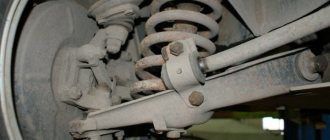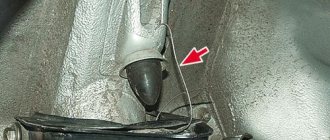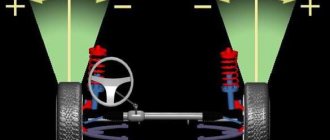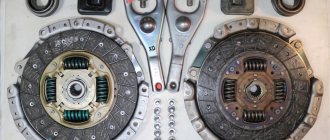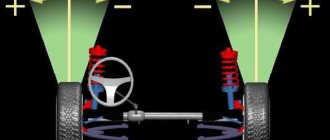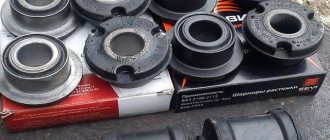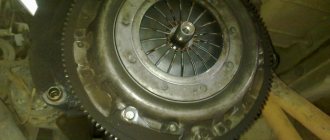Springs
Let's imagine that the front of our car has soft springs. When braking, the front end receives an additional 200 kg of load and sags, for example, by two centimeters. Installing stiffer springs will reduce this sag by up to one centimeter. But the additional weight will remain the same. The only thing that will change is the reaction—the suspension travel. If you want to completely eliminate sagging of the front end, then replace the springs with a rigid structure, for example, cuttings of steel pipes. Plunging when braking will disappear completely. But the redistribution of weight will not go away - the same 200 kg will put pressure on the front wheels. Consequently, the springs only determine the suspension travel - how much it compresses under the influence of additional weight.
Determine the problem by eye
When the springs are heavily worn, they sag, and all that is required in this case is to inspect the car, paying attention to its fit. The car is lower than it should be - a sure sign of “fatigue” shock absorber springs
This also makes it impossible to adjust the wheel camber.
Ball joints are checked in an inspection hole; this is somewhat more difficult, as it requires the ability to look under the car, as well as the presence of a mount. Press the lower control arm bushings and check how they move up and down. If there are no backlashes, and the rubber on the parts is intact, then everything is in order and you don’t have to worry.
Causes of spring failure
There are five main reasons why rear and/or front springs fail completely or partially.
- Metal fatigue and spring wear . This happens for natural reasons over time. During operation, the metal becomes softer and more pliable, and accordingly, the spring becomes softer. And also when the coils of the spring collide, the springs rust and microcracks appear. Particularly harmful to the rods are the strong impacts that occur when a car hits a pothole or bump at high speed.
- Constant friction of the coils of a weakened or heavily loaded spring among themselves. For this reason, the spring stiffness decreases, and the surface of the coils themselves becomes not round, as it was initially, but has a worn-out plane. Accordingly, for this reason the rod becomes thinner, and therefore the spring becomes weaker.
- Overloading a car and driving it in this condition at high speed over uneven surfaces or distances. In such conditions, all suspension elements suffer, including springs.
- Corrosion of metal springs . This is a very common reason why springs fail. Over time, the paint on their surface peels off, and water and road reagents do their job. Interestingly, if corrosion “ate” only a 0.15 mm layer on a 10 mm spring wire, then the cross-section of the said wire is reduced by as much as 6%!
- Installing the wrong spring . In particular, this can happen due to incorrect selection of parts. Another option is a factory defect. It often happens that springs with different stiffnesses are placed in one package.
Installation Tips
- Is it possible to install parts of different classes?
Remember that the springs on the suspension must be of the same class. Let’s say you installed A-class parts on the front suspension, which means you also need to install “A” class on the rear suspension.
If a similar class is not available for the rear suspension, then in exceptional cases class “B” is assigned to the rear suspension.
If B-class springs are installed on the front suspension, then class “A” springs cannot be installed on the rear suspension.
Install suspensions of the same class on the left and right sides of the same axle.
- What springs are better to install on a VAZ 2107?
Before changing parts, make sure that it is really necessary. You can check it in the following way: standing at the front of the VAZ 2107, swing the body down. If it quickly rises to its original position, there is no need to replace the springs; they are in good condition. If the body does not rise and continues to sway, then replacement is necessary. In the same way you can check the rear suspension of the VAZ 2107.
To improve the aerodynamics of the VAZ 2107 and improve the sensitivity of the steering wheel, it is recommended to install stiffer springs than the original ones. You can buy those designed for VAZ 2104, cut off one turn. It is imperative that on a VAZ 2107 you need to change two at the same time, otherwise the car will lose stability on the roads.
It is not recommended to install reinforced rubber gaskets on 2107, because the spring will break through.
- Will Niva springs fit on a VAZ 2107?
If you want to make a sports tuning on the VAZ-2107, the suspension is made more rigid, this improves the quality of handling without reducing the level of comfort.
The rear springs are stiffer than the front ones. The factory ones are too soft, and the car quickly loses control, the bottom gets scratched on the road surface. To increase the stiffness of the suspension, it is recommended to install Niva springs on the VAZ 2107.
- What springs are better to install on a VAZ 2110?
On the VAZ 2110, the front spring often breaks due to poor quality roads, so it needs to be replaced. Moreover, you can do this yourself, without contacting a car service. All that remains is to find out what is best to choose from the range offered for the 2110.
On the front suspension of the VAZ-2110, as standard, 2108 springs are installed, on the rear suspension - 2110. In the absence of original parts, car enthusiasts are advised to install SS20 highway, the car rides smoothly and is stable when cornering.
- What springs are best to put on a Priora?
If the springs on the Priora have sagged, it is recommended to install new original ones from VAZ. Choose only the class depending on the goals of your tuning. Class "A" is more stringent. In the absence of the original one, according to car enthusiasts, it is better to install a kit with a lowering Eibach Pro-Kit (-30 mm).
- What springs are better to install on a VAZ 2114?
The VAZ 2114 suspension is quite durable, and the need to replace parts occurs quite rarely. Therefore, not all car owners of 2114 cars know what is best to choose from the wide range offered on the markets.
Sometimes springs from 2112 are installed on a VAZ 2114, they are a little stiffer, designed for a larger weight of the car, so they raise the 2112 slightly - by 2-3 cm, which means that in this way you can increase cross-country ability. If, on the contrary, there is a desire to lower the car, then it is recommended to purchase an Eibach, with the front ones being -5 and the rear ones -7, so that the car does not ride up.
So, the choice of springs for VAZ is quite wide, the main thing is to choose the correct stiffness characteristics according to the load on the car and operating conditions. You will find a variety of advice on forums and blogs. Of course, it is better to first consult with specialists. Refusal of original parts in favor of other manufacturers may be dictated by the desire to improve the driving performance of the car, but be sure to compare the cost of tuning and the result obtained.
Types of springs
Standard elements can sag very quickly, and therefore the question may arise about which elements are best to install. There are more manufacturers on the market, but each car owner chooses for himself based on the price and quality of the product, so let’s look at a few of the most popular ones as an example:
- The manufacturer Izh-Techno is an excellent replacement for standard products; they have a longer service life, unlike their original ones. The price per set varies from 2800 to 3200 rubles. Therefore, if you do not want to overpay, this option is perfect for you.
- Manufactured by Kilen, they are produced in Sweden, so their price is quite high, the price of one element will be from one thousand to one and a half thousand rubles. The width of the coils, in contrast to the standard ones for which it is 13 millimeters, is 14 millimeters for the front and rear 14.9 millimeters.
- Manufactured by Lesjofors, it is practically an analogue of Klien, they even have the same number designations.
- Manufacturer Raid, they are the most popular and occupy a leading position. The production of these springs is carried out by three enterprises, painting is carried out by a Swiss complex, coiling is done on equipment from the USA, and the product is produced by a company from Russia. Having installed these springs, the SUV becomes completely unrecognizable, and every hole that comes along the way begins to be extinguished already in the initial stages. The price for two spare parts is about three thousand.
Do I need to change springs as a set for all wheels?
Wheel torn by a piece of spring
This question cannot be answered unambiguously. On the one hand, many experts recommend replacing the entire set of springs in a circle. On the other hand, if you are the owner of a front-wheel drive car, then most likely the rear springs and shock absorbers of your car will last 1.5-2 times longer than the front elements. There will simply be less load on them. This means that if the springs are not rusty, why replace them with new ones? All you have to do is change the front ones and move on!
Springs SS20 Classic for VAZ suspension
Spring class value
Standard test method: after manufacturing, the spring is compressed to a control height, determining the load required for this. According to it, springs are sorted into classes, which are marked on the coils with paint of different colors (VAZ) or marks (Moskvich). As in any production, control of springs (sorting by class) is accompanied by various tolerances and these tolerances are quite wide, i.e. the height of two springs of the same class (under control load) may differ by 16 mm, which means the body is skewed.
The height of the body on the right and left with springs of the same class should not differ by more than 4 mm. Studies of springs from various manufacturers have revealed a number of significant shortcomings.
Advantages of SS20 springs
Selective selection of pairs (within a class) with the most identical characteristics ensures the best contact of the car with the road surface, stability, controllability, reliability and comfort.
We carry out 100% quality control, the geometry of the springs, support and working coils, and conduct life tests, so SS20 springs remain operational for at least 5 years.
SS20 springs have increased resistance of the paintwork to abrasion, chips and scratches, which is very important, since the springs operate in fairly aggressive conditions (water, sand, crushed stone, salt from the road surface). Special spring steel (60S2G), from which really high-quality springs are made, contains a large amount of carbon, i.e.
any scratch will lead to rapid oxidation (rust), which will negatively affect the resource.
Springs must be replaced in pairs, even if only one spring is defective. It is allowed to install springs of the same type with the same characteristics on one axle. SS20 springs are installed instead of standard ones and do not require modification of other suspension parts.
Springs are replaced when one of them breaks or excessively settles, or when they all “sag” during operation. The defect of one spring can be easily determined by the obvious distortion of the body, and it is necessary to take into account the condition of the supports, silent blocks, and tires. Frequent activation of the suspension up to the travel limiters (“breakdowns”) is also a sign of “sagging” springs.
Checking the validity of springs
- install new springs;
- after a run of 2 thousand kilometers, measure the vertical distance from the wheel axis to the wing;
- If this distance decreases during operation by more than 20%, the spring must be replaced.
Measurements should be carried out on a flat, horizontal area, taking into account the condition of the dampers of the supports and silent blocks.
Rear springs SS20
We recommend using springs using a protective polyurethane braid. The braid will protect the spring coils from impact and destruction, eliminate knocking and increase the service life of the suspension springs.
Replacing front springs
You can change the springs yourself in the garage if you have two jacks, spring ties and call a friend to help. It’s better to change it on a lift; if a nut won’t come off, there’s a better chance of unscrewing it.
On my car, the front struts were removed quite easily, all the nuts were unscrewed without much difficulty, of course, not without VeDeshka. We remove the stabilizer struts and unscrew the two bolts on the strut, and also unscrew the two bolts that hold the brake pipes.
Unscrew the bolts
Loosen the brake pipe fastenings
Under the hood, unscrew the three nuts that hold the rack on top. The green marks on the cup should face each other
We tighten the springs with zip ties, disassemble the rack and change the springs
Rear suspension
Here the situation is almost the same. Although the suspension design is radically different. Here the shock absorber is not inserted directly into the spring, but comes as if separately. That is, if it is “covered”, it is much easier to replace it! Just unscrew two bolts and remove it, then install a new one.
If you don't haul heavy loads and your vehicle is front-wheel drive (all the weight is in the front), then the rear end will suffer much less. I know from experience that there will be a replacement in 150 - 200 thousand, and maybe more. However, it is advisable to change everything at once.
I hope I helped - sincerely yours, AUTOBLOGGER.
We determine the malfunction on the go
This is one of the most accurate ways to know whether the shock absorber is working properly. How can I check its condition? You need to carefully monitor the behavior of the car. If the car is constantly “looking for the way”, reluctantly reacts to the steering wheel and sways at the slightest irregularities, it means that the damping elements have become unusable. In large holes, characteristic dull impacts will be heard. But they do not always occur due to a broken piston. The silent block that holds the shock absorber in the upper or lower part may have worn out. During diagnostics, check the vehicle's behavior when cornering.
What are shock absorbers and springs
The shock absorber and spring are an inseparable duet. Their main task is to make the car move as smoothly as possible and under control of the steering. The spring, due to its elasticity, smoothes out the shaking and shocks that are inevitable when the car moves over uneven roads. When a car hits a pothole at any speed, the wheel jumps up. For a moment there is a loss of adhesion between the rubber and the road surface. The spring's job is to push the wheel down to the road as quickly as possible, because the "bounce" locks the steering.
But the spring doesn't just push down. It makes oscillatory movements, extinguishing the impact energy. The number of vibrations depends on the elasticity of the spring. The softer the steel from which the iron spiral was made, the stronger the compression and damping of impact energy.
What is the effect of a faulty shock absorber?
The use of worn shock absorbers can not only cause discomfort while driving, but also cause a real danger when driving the car. So, possible problems associated with a faulty shock absorber:
- Reduced wheel grip. In particular, when the car rocks, the clutch will have a variable value.
- Increased braking distance, especially on vehicles with an anti-lock braking system (ABS).
- Some electronic systems of the car, such as ABS, ESP (exchange stability system) and others, may not operate correctly.
- Deterioration in vehicle handling, especially when driving at high speed.
- The appearance of “hydroplaning” when driving on a wet road at low speeds.
- When driving at night, constant rocking of the front of the car can cause the headlights to blind oncoming drivers.
- Discomfort when driving. This is especially true when driving long distances. For the driver, this threatens increased fatigue, and for people prone to seasickness, this is dangerous due to motion sickness.
- Increased wear of tires, rubber bushings, silent blocks, bump stops and springs. and other elements of the car suspension.
How to check the spring?
First of all, it is necessary to perform a visual inspection for cracks or damage to the spring. If there are any, replacing the springs is inevitable
If there are no cracks, then you should pay attention to the coils; if there is a sign of contact on them, you can safely assume that the metal is “tired” and the spring has lost its elasticity and has become inoperative
What affects the elasticity of a suspension spring?
- Thickness of the coil. The stiffness depends on how thick the rod (coil) is;
- Overall spring diameter. Here, on the contrary, the larger the spring diameter, the softer the spring will be;
- Number of turns. The more turns, the greater the rigidity;
- The shape of the spring (it can be different: cylindrical, conical or barrel-shaped).
The spring stiffness is determined by the manufacturer itself, after which special markings are applied. For more information, please contact the spring manufacturer.
Stretched spring - reasons
If the spring is faulty, this does not mean that it is of poor quality or that you have been deceived. There are a number of factors that are involved in premature spring failure, including:
- Natural wear and tear
. Too frequent use in difficult conditions or simply high mileage. Nothing lasts forever, perhaps the spring has simply exhausted its resource. Each spring has its own resource, approximately 50-80 thousand km. mileage - Incorrect operation
. If you constantly load your car or carry more weight than expected, the springs will last much less than if you were driving alone or with minimal additional weight. - and reagents
. These factors need no introduction or explanation. Once the rust penetrates under the paint of the spring, it does its dirty work, day after day, eating away at the surface of the spring, weakening it. The same is with reagents; they aggressively affect the metal, destroying its surface and worsening its properties.
When is it necessary to diagnose a car's chassis?
Most often, there are three reasons for the failure of the vehicle's chassis. The first of them is low quality components. Unreliable spare parts increase the load on the chassis as a whole, which increases the likelihood of its failure. Much also depends on the qualifications of the specialist repairing the machine. Often, in pursuit of savings, motorists entrust chassis repairs to home-grown craftsmen, preferring cheapness to quality. But the most important destructive factor is the condition of the roads. Constantly driving on a road surface with holes and potholes will inevitably lead to failure of the chassis.
How do you know if you need to diagnose your suspension? If unnecessary sounds appear in the chassis, such as clicks, knocking, clanging, rumble, and also if road irregularities are well reflected in the steering wheel and are felt by the body, then the wear is already critical. The situation can be corrected only by replacing a few parts. Therefore, diagnostics become necessary in order to identify all faulty elements.
It is preferable to carry out chassis diagnostics as a planned event as part of regular vehicle maintenance. In this case, it is possible to avoid serious breakdowns and associated high costs.
Separately, it is worth considering the situation with buying a used car. In this case, identifying defects in the chassis can significantly reduce the price, or even force you to abandon the purchase of this car altogether. Chassis diagnostics are often carried out at a service station before purchase. However, you shouldn’t trust the opinion of even professional car experts too much. After all, they are not as motivated as a potential buyer. Therefore, it is better to be present in person when a specialist inspects the chassis of the car. The number of detected defects in this case sometimes increases greatly.
Each car is a rather complex engineering product that requires certain maintenance. During operation, all parts of the car wear out. Some components periodically require replacement, others need repair. Serious breakdowns can be prevented by promptly identifying and eliminating emerging faults. Since the condition of the roads in our country leaves much to be desired, diagnostics and repair of the vehicle’s chassis are most often necessary.
In the old days, the expression “a good knock will come out on its own” never left the lips of car owners. The spread of this opinion was facilitated by the small number of professional car services and the high cost of their services. Spare parts for cars were a scarce commodity. Therefore, many drivers continued to operate the car with obvious faults until it completely broke down.
A very alarming sign indicating the need for diagnostics is the unpredictable behavior of the car on the road. This phenomenon occurs more often during city driving. When driving outside the city, due to high speed, the car is pressed against the asphalt by the incoming air flow. This downforce minimizes play in the chassis components.
It is very important to diagnose the chassis in a timely manner. Too much monitoring is pointless
It is optimal if the interval between diagnostics is about six months. For example, you can link this operation to a seasonal tire change. However, when covering a mileage of 10,000 km, it is necessary to carry out a comprehensive diagnosis of the vehicle’s chassis.
The roads in our country are characterized by poor-quality asphalt. Therefore, even a car wheel falling into a deep hole is an excellent reason for an extraordinary check of the chassis. Often the result of the interaction of the suspension with road defects manifests itself immediately in the form of knocking, humming, play in the steering, the car begins to pull to the side, and so on.
Wrong type
Among the abundance of designs, you should choose products that best match the original elements in shape, height, and rigidity:
- The number of turns and height may vary. The main thing is the complete coincidence of the seat and outer diameter. The easiest way to choose the right springs is with the help of branded catalogs offering their products for various cars.
- The durability of springs depends on the absence of technological defects. In addition, this parameter is directly affected by violation of recommendations for their selection and the use of unsuitable shock absorbers.
- Color markings may vary from manufacturer to manufacturer. The diameter of the spring rod may also vary. When choosing this suspension element, it is important to focus on the manufacturer, the type of product, which is determined using markings, and rigidity.
Changing the suspension design using artisanal methods has an extremely negative effect on the operation of the springs.
For example, installing elements from station wagons on sedans in case of sagging of the car body is justified. On the other hand, if this is done to increase load capacity, then this is an unjustified step, since reinforced structures can damage the body over time.
An unsuitable type can lead to loss of controllability, deterioration of road stability, damage to the body and shock absorbers.
In addition, the wrong type of products installed on a car often leads to failures of the ABS and ESP electronic systems. This can even lead to ECU failure.
Incorrect springs change ground clearance and wheel alignment angles. As a result, parts, chassis components, and tires wear out much faster.
What suspension elements need diagnostics?
So, what needs to be done if there is a knock in the suspension, and we’ll also talk about the reasons for its occurrence. First of all, we need to clarify something... If the suspension rattles, it means this is the result of a malfunction or incorrect operation of any part or chassis mechanism, for example, the following may fail:
- Shock absorber;
- Spring;
- Spherical bearing;
- Lower arm with silent block;
- Upper suspension support with bearings;
- Stabilizer link;
- Stabilizer support;
- Steering rack;
- Tie Rod;
- Steering tips;
- Wheel bearing;
- Steering cardan;
- CV joint (outer joint).
It will not be possible to determine the malfunction by ear, nor will it be possible to find the source of this knocking noise in the front suspension. In order to find the malfunction, it is necessary to carry out a thorough diagnosis.
Driving and on the move
Some defects are diagnosed while driving, or simply from behind the wheel in a static position. Problems with the steering rack are diagnosed by turning the steering wheel to the side and rocking the rack. Usually the cause of problems with this mechanism is wear of the guide bushing.
Steering rods and ends are also checked by moving the steering wheel, but not once, and from side to side. In this case, you will need an assistant, since while moving the steering wheel you need to hold on to the steering tips and rods - they should not play. If there is play, it means the tips are faulty and require replacement.
The easiest way to determine the condition of the hub bearing is while driving - in the event of a malfunction, it emits a loud and uniform hum; it will be difficult not to hear it even with good sound insulation of the car. The condition of the wheel bearing can be determined by hanging it: spin the wheel, or swing it at the top point, and check for play.
Since you have taken to studying the car's suspension seriously and asked the car seller for a test drive, test the outer CV joints that make a cracking noise when turning sharply with acceleration. Carry out a maneuver and listen to how the car reacts.
How old springs can quickly “kill” shock absorbers and suspension: review and solution to the problem
Did you know that motorists are increasingly faced with one extremely interesting problem, which is not only difficult to identify during a technical inspection, but is not always possible to feel after an immediate breakdown? What kind of problem is this peculiar? It probably occurs in a very small and unimportant system of the car. Well, if you only consider that car springs are an insignificant and unimportant detail
Yes, as it turns out, more and more often owners of old cars are faced with breakdowns of the suspension springs of their cars. But this is only one side of the problem. According to the second, there are already frequent cases of springs breaking on relatively new cars, literally a few years after the car leaves the factory gates. Moreover, the first signs of the beginning epidemic of breakdowns were found in Europe, which is relatively good in terms of road quality. In particular, the problem is observed in Poland. So what happens to one of the main suspension elements? But before answering this question, let’s first quickly remember what a car spring is and why it is needed.
Springs play a very important role in the suspension, because we are talking about suppressing shocks and overloads caused by the movement of unsprung masses (wheels, brakes, suspension elements), that is, ensuring comfort while driving, safety and maintaining a given ground clearance under the bottom of the vehicle.
Springs also reduce the forces acting on the suspension. Without springs, the car would be impossible to drive at all.
For example, without shock absorbers you can at least drive slowly, but without springs it is almost impossible to do this! Why is such an important element discussed so little in reviews? Why don't they pay him enough attention?
Everything is quite prosaic. First: since coiled elements do not require maintenance, they wear out very slowly, and until mechanical and very significant damage occurs, it will be difficult for the driver to feel the difference when driving between a new spring and one that has traveled a hundred or two thousand kilometers.
Yes, the car will slowly lose ground clearance all this time, but that seems to be the whole difference. You are unlikely to feel any mechanical deterioration in handling.
The tag will tell you that these springs were on the car from the very beginning.
But what’s more interesting is that even cracking of the spring coils cannot cause major complications in the car’s handling, since damage usually occurs at the very end of the winding, at the place where the spring is fastened to the body or suspension, the so-called spring socket.
In addition, the length of the spring itself does not change significantly even after breaking until both parts of the spring move relative to each other. Only after this the height of one of the wheels drops slightly, which, however, may also go unnoticed by the motorist.
Signs of faulty suspension springs
For the need to check the fatigue of car suspension springs, one or more signs may appear. Among them:
- It is visible to the naked eye that one of the sides of the car “sank” more than the other in an unloaded state (without cargo and passengers). You need to look at one axis, that is, for example, compare the front left and front right springs. In such cases, most likely the spring has sagged or broken completely (on the sagging side). However, there is a nuance here, which consists in the fact that the subsidence of one or the other side can be influenced by the so-called glass, that is, the place where the spring rests. Often on old cars (most often VAZ “classics”) the glass falls through. When diagnosing, you will need to check both the fatigue of the spring and the cup.
- A metallic clanging sound while driving on rough roads is a clear sign of a broken suspension spring. Moreover, this clanging sound can be produced even when driving over small bumps or potholes. However, in this case it makes sense to also check the steering rack and ball. A metallic clanging sound usually indicates that one of the spring coils has partially or completely snapped.
- Low landing of the machine when loading, even lightly. Especially if everything was fine before and such a phenomenon was not observed. Typically, this problem is more common on the rear springs, and at the same time the wheels begin to scrape against the wheel arch liners, and the mud flaps begin to touch the road surface. This is a very dangerous situation, because in this way, in emergency mode, the tires wear out, and at one “wonderful” moment they can simply burst.
- Strong vibration and shaking while the car is moving, even on a flat road. In this case, the shaking increases as the speed of the machine increases. As a rule, this is a sign that the spring has burst completely.
- Reduced ride quality . This can be seen by comparing the operation of the machine before and after the problem occurred. Usually the spring stops working normally and when driving over bumps the car jumps or dives into a hole.
- Significant car roll even with gentle braking.
If at least one of the above symptoms appears, it makes sense to perform a comprehensive diagnosis of the suspension, including checking the shock absorber springs. Moreover, it is advisable to perform the check not only on the side where the car sank, but on all the others too.
Typical faults
Many car owners love to drive their car until the suspension starts making different sounds. The most common sign is knocking, crunching, and squeaking. If the suspension knocks, this indicates that the rubber parts have worn out, and the fastenings in the mechanism have become loose.
How to find out what exactly is knocking? Only diagnosing the suspension yourself will help here. Most drivers notice a crunching sound when turning. In this case, you need to inspect all the parts that are involved in operating the machine. Squeaks may indicate wear of the rubber elements. But only an experienced specialist can determine the malfunction by hearing. If you hear unusual sounds, check the system and replace faulty or worn parts. Take this seriously and conduct such examinations regularly.
This will significantly increase traffic safety. By following the list of these actions, you will be able to save money, because the price for such a service as suspension diagnostics is considerable (from 4,000 rubles). And the experience gained in this way cannot be bought for any money.
Malfunctions of the vehicle's chassis.
When operating a vehicle on domestic roads, constant attention must be paid to the condition of the chassis. Car chassis, chassis, suspension – these are all synonymous words that describe one of the integral parts of your car.
The chassis is a set of components and parts that provide comfort, dynamics and controllability of your car while driving. Any driver, professional or not, feels his car intuitively or by ear. And when, while moving at different speeds, he suddenly begins to hear some extraneous sounds, the question arises, what could it be? And very often the cause of extraneous noise lies in a malfunction of the vehicle's chassis. During operation, malfunctions may occur in the vehicle suspension due to wear and tear of parts. The technical condition of the chassis can be assessed by deviations in the dimensions of parts from those provided during assembly at the factory and permissible wear and gaps in the main mating parts, as well as by the condition of the working surfaces of suspension parts.
Most car suspension malfunctions either occur unexpectedly, for example, after driving on a bad road, or appear gradually, sometimes over a fairly long period of time. Both extraneous sounds emanating from the faulty mechanism and “inappropriate behavior” of your car begin to warn about the impending failure of any part and, accordingly, the repair of the chassis.
Warning: Before determining a suspension problem, check the tire pressure, the absence of wheel braking, and the installation of identical tires on the vehicle.
Main suspension parts
It is best to check the main components and parts of the suspension while driving; the sounds will tell you in detail whether there are any malfunctions. The car needs to be driven over uneven surfaces, such as rails or bumps, but without fanaticism, so as not to damage the vehicle.
The main components, the condition of which you need to know:
- Shock absorber - serves to dampen vibrations. If the car rocks strongly, the shock absorber is faulty.
- A spring is an integral part of the shock absorber; if it sags or bursts, the car becomes significantly lower than the factory setting.
- The ball joint is mounted on the lever on one side, and on the steering knuckle on the other. Responsible for turning the steering wheel.
- Lower arm – attached to the body at two points, ensures the operation of the suspension. There are silent blocks at the attachment points to the body.
- Stabilizer link - connects the stabilizer and the strut, thus connecting it to the suspension.
- Steering rack - transmits force from the steering wheel to the steering knuckles. When turning the steering wheel, there should be no play and no extraneous sounds.
The suspension itself will tell you about the main points, but if you want to know everything in detail, then it’s better not only to look under the car and ride it, but also contact service specialists who, using a lift, will be able to examine the condition of the suspension parts and tell you exactly what there is a problem.
